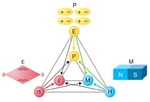Prof. Dr. Nicola Spaldin
ETHZ
From Multiferroics to Cosmology: Studying the early universe under the microscope
Donnerstag 3. Mai 2018,
um 19:30 Uhr
ETH Hauptgebäude Hörsaal HG G5, Rämistrasse 101
|

|
|
Phase control in ferroics and multiferroics (Image: ETHZ)
|
|
The behavior of the early universe just after the Big Bang is one of the most intriguing basic questions in all of science, and is extraordinarily difficult to answer because of insurmountable issues associated with replaying the Big Bang in the laboratory. One route to the answer - which lies at the intersection between cosmology and materials physics - is to use laboratory materials to test the so-called "Kibble-Zurek" scaling laws proposed for the formation of defects such as cosmic strings in the early universe.
Here I will show that a popular multiferroic material, hexagonal yttrium manganite - with its coexisting magnetic, ferroelectric and structural phase transitions - generates the crystallographic equivalent of cosmic strings. I will describe how straightforward solution of the Schroedinger equation for yttrium manganite allows the important features of its behavior to be identified and quantified, and present experimental results of what seem to be the first unambiguous demonstration of Kibble-Zurek scaling in a real material.
I will end with some very recent data showing that things might be less unambiguous than they seem.
Learn from Nicola Spaldin's talk at the 2017 WORLD.MINDS Annual Symposium.
[Wegbeschreibungen]
[Veranstaltungs-Uebersicht]
[BACK]
